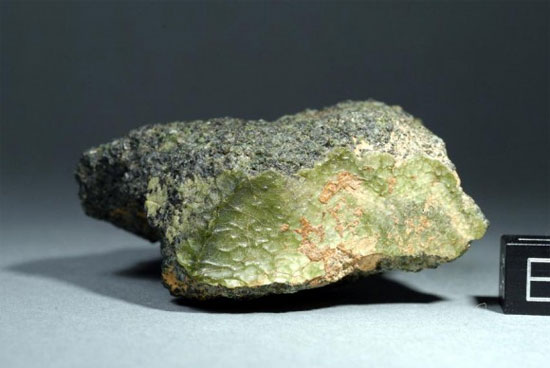Stone from Mercury has fallen to Earth
The blue stones that scientists found in Morocco last year could come from the planet closest to the sun.
Many people saw a meteorite on fire in the sky in North Africa in July last year, but it was not until late December that scientists discovered its fragments at a place near the city of Foumzgit in Morocco. The total mass of rock pieces is found to be about 7kg. The largest stone has a mass of more than 1kg. Many experts guess they come from Mars.

A blue stone in the NWA 7325 group. (Photo: Space)
NWA 7325 is the name of a group of 35 meteorites mentioned above.At a conference of planetary researchers in The Woodlands, Texas, USA, Anthony Irving, a meteorite expert in the US, claimed that the age of the NWA 7325 was about 4.56 billion years and they were not from the red planet, Space reported.
"Maybe they come from Mercury," Irving said.
Irving and a University of Washington astronomical professor in the United States have studied earth meteorites for many years, but they have never seen blue skies like NWA 7325.
Meteors from Mars carry elements in the atmosphere of the red planet. So scientists can identify them easily. Stone from Vesta, one of the largest meteorites in the solar system, also contains specific chemical elements. But NWA 7325 is not like meteorites that experts have collected and studied.
"I think the rocks were thrown out of Mercury due to the phenomenon of magma erupting on the surface of the planet at a time in the past. The evidence shows that the pieces of rock used to be foam on the mouth of a volcano" , Irving to speak.
The NWA 7325 has a lower magnetic field strength than any meteorite that has ever hit the earth.
"Data from Messenger - the spacecraft flying around Mercury - shows that its magnetic field strength is similar to the NWA 7325 rock group , " said.
Scientists who studied Mercury say that the iron density on the planet's surface is very low. Iron density in the NWA 7325 group is also very low, indicating that they are likely to come from Mercury, or some object like Mercury.
- Overview of Mercury
- Photos never published about Mercury
- Things you may not know about Mercury
- Mercury '1 day' by 2 years
- Astonishing image: Mercury passes between the Earth and the Sun
- Evidence that Mercury is not a dead planet
- 10 types of death stones in the blink of an eye
- What happens when you drink mercury?
- Mercury is no different from a raisin fruit turning around the Sun.
- Mist containing mercury poisoned the US city
- Explore Mercury from Messenger spacecraft
- Symptoms of mercury poisoning and how to prevent it
 Van Allen's belt and evidence that the Apollo 11 mission to the Moon was myth
Van Allen's belt and evidence that the Apollo 11 mission to the Moon was myth The levels of civilization in the universe (Kardashev scale)
The levels of civilization in the universe (Kardashev scale) Today Mars, the sun and the Earth are aligned
Today Mars, the sun and the Earth are aligned The Amazon owner announced a secret plan to build a space base for thousands of people
The Amazon owner announced a secret plan to build a space base for thousands of people